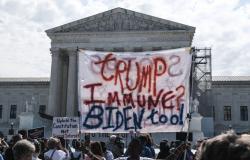Flags, whistles and vuvuzelas against rubber bullets, tear gas and water cannons: the police tried on Tuesday to prevent the gathering of hundreds of people in the Kenyan capital Nairobi, for the third day of an anti-government mobilization led by youth.
• Read also: Kenya: government spending provokes public anger
• Read also: Kenya: hundreds of people demonstrate against the rights of LGBT+ people
• Read also: Kenya: six people killed in protests
Clashes broke out in the center of the Kenyan capital Nairobi between police officers and demonstrators mobilized against government tax projects, AFP journalists noted.
Around midday, some demonstrators threw stones in the direction of police forces after advancing in an area of the central business district (CBD) housing official buildings, including Parliament where a controversial draft budget is currently being discussed. Police responded with tear gas and rubber bullets.
Real bullets
One person was killed by the police, announced the NGO Kenya Human Rights Commission (KHRC).
“Police shot four protesters, as witnessed by KHRC, killing one. We strongly condemn the killing of the police. Such acts are unacceptable and constitute a serious violation of human rights (…),” said the NGO in a message on X. AFP journalists saw at least three inanimate bodies near the Parliament.
AFP
Fire in the governor’s office
The offices of the governor of the Kenyan capital Nairobi were on fire, according to images broadcast by Citizen TV.
![[EN IMAGES] Protests in Kenya: fire, shooting and protester killed in Nairobi](https://euro.dayfr.com/content/uploads/2024/06/25/6dd5f94a79.jpg)
AFP
Police used a law enforcement water cannon to try to put out the fire on the ground floor of the building in Nairobi’s central business district, a few hundred meters from Parliament which had was previously stormed by demonstrators.
3rd day of demonstrations
For this third day of action, organizers called for demonstrations across the country and a general strike.
The movement called “Occupy Parliament” was launched on social networks shortly after the presentation to Parliament on June 13 of the 2024-2025 budget providing for the introduction of new taxes – including a 16% VAT on bread and an annual tax of 2.5% on private vehicles.
After a first demonstration on June 18 in Nairobi by a few hundred people, mainly young people from “Generation Z” (born after 1997), the government announced that it would abandon most of the planned taxes.
![[EN IMAGES] Protests in Kenya: fire, shooting and protester killed in Nairobi](https://euro.dayfr.com/content/uploads/2024/06/25/079d63c174.jpg)
AFP
But the hashtag #RejectFinanceBill2024 (“Rejection of the 2024 draft budget”) crystallized wider discontent among the population, hit by economic difficulties for several years, and on June 20 processions marched in many cities.
Police violence
Anti-tax demands have turned into a challenge to the policies of President Ruto, who said he was ready to dialogue with young people on Sunday.
“We have passed the stage of discussions and we cannot be silenced,” one of the organizers of the movement, journalist and activist Hanifa Adan, responded to AFP on Sunday.
Largely peaceful, the first two days of mobilization were marked by the death of two people in Nairobi.
![[EN IMAGES] Protests in Kenya: fire, shooting and protester killed in Nairobi](https://euro.dayfr.com/content/uploads/2024/06/25/58062c7db7.jpg)
AFP
Several dozen others were injured by police, who also made hundreds of arrests.
“Despite mass arrests and injuries, the demonstrations continued to grow, highlighting the general discontent of the population,” Amnesty International Kenya said in a statement on Monday, warning of a risk of “escalation ( which) could lead to more deaths.
The NGO Kenya Human Rights Commission (KHRC) accused the authorities of carrying out kidnappings of activists, carried out “mainly at night (…) by police officers in plain clothes and in unmarked cars”.
![[EN IMAGES] Protests in Kenya: fire, shooting and protester killed in Nairobi](https://euro.dayfr.com/content/uploads/2024/06/25/38f9178fa7.jpg)
AFP
Kenyan police spokesperson Resila Onyango did not respond to requests from AFP about these accusations.
Total withdrawal
The draft budget must be voted on in Parliament before the end of the fiscal year on June 30.
The demonstrators are demanding the complete withdrawal of the text, denouncing the sleight of hand of the government which announced the withdrawal of certain tax measures but plans to compensate them with others, in particular a 50% increase in fuel taxes.
For the government, these taxes are necessary to restore room for maneuver to the country, which is heavily in debt.
Kenya, an East African country of around 52 million inhabitants, is an economic powerhouse in the region.
But the country recorded inflation of 5.1% year-on-year in May, with food and fuel prices rising by 6.2% and 7.8% respectively, according to the Central Bank.

![[EN IMAGES] Protests in Kenya: fire, shooting and protester killed in Nairobi](https://euro.dayfr.com/temp/resized/medium_2024-06-25-3f1ddba0a5.jpg)
![[EN IMAGES] Protests in Kenya: fire, shooting and protester killed in Nairobi](https://euro.dayfr.com/temp/resized/medium_2024-06-25-9d386a19a7.jpg)
![[EN IMAGES] Protests in Kenya: fire, shooting and protester killed in Nairobi](https://euro.dayfr.com/temp/resized/medium_2024-06-25-6dd5f94a79.jpg)
![[EN IMAGES] Protests in Kenya: fire, shooting and protester killed in Nairobi](https://euro.dayfr.com/temp/resized/medium_2024-06-25-079d63c174.jpg)
![[EN IMAGES] Protests in Kenya: fire, shooting and protester killed in Nairobi](https://euro.dayfr.com/temp/resized/medium_2024-06-25-58062c7db7.jpg)
![[EN IMAGES] Protests in Kenya: fire, shooting and protester killed in Nairobi](https://euro.dayfr.com/temp/resized/medium_2024-06-25-38f9178fa7.jpg)




